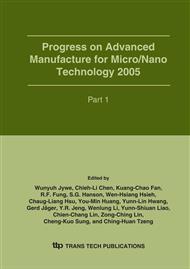p.409
p.415
p.421
p.427
p.433
p.439
p.445
p.451
p.457
Computational Modeling of Micro-Fluid Flow in a Tubular Microchannel
Abstract:
This paper develops models for micro-fluid flow in tubular microchannels with uniform or varying cross-sections. The fluid flow is governed by the pressure drop, the capillary force, and the viscous force. The governing equation developed for the flow incorporates two geometry parameters, namely the cross-section perimeter, S, and the cross-section area, A. In a microchannel with a uniform cross-section, the governing equation reduces to a linear initial value problem which can be solved analytically. However, in the case of a varying cross-section, the two geometry parameters vary as a function of the flow front position, L, and the nonlinear initial value problem must be solved numerically. The computational models developed in this study will be able to provide accurate predictions of the micro-fluid flow behavior in microchannels with uniform or varying cross-sections.
Info:
Periodical:
Pages:
433-438
Citation:
Online since:
January 2006
Authors:
Keywords:
Price:
Сopyright:
© 2006 Trans Tech Publications Ltd. All Rights Reserved
Share:
Citation:


